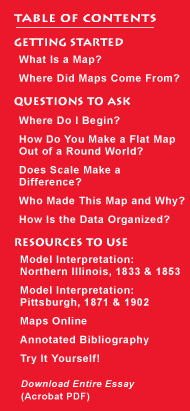talking history | syllabi | students | teachers | puzzle | about us
 |
Maps represent a scale model of the world. To fit on a piece of paper the world has to be greatly reduced in size. A map's scale is a statement about the relationship between map distance and distance in the real world -- the amount of reduction that has occurred to get the representation of the world to fit on a sheet of paper. By convention, the scale is given as a ratio between distance on a map -- expressed as one unit of distance -- and real world distance -- the number of the same units of distance in the real word. Thus, on a map with the scale 1:633,600, one inch on the map would be equal to 633,600 inches in the real world. This scale may also be written as one inch equals 10 miles. Scales are also represented graphically. A graphic scale is a bar that has been calibrated to show map distances. When working with any maps that have been enlarged, reduced, or reproduced on a computer monitor, this graphic scale is absolutely essential. On maps that have been reduced or enlarged by photocopying, the original ratio and written scales are incorrect, since the relationship between map distance and real world distance has been altered. But if the graphic scale has been enlarged or reduced to the same extent as the map, it is still correct. To explore the concept of scale more fully see the links about map scale at about.com, especially the link to about.com's own guide. Map scales can be divided into two categories, large and small. Geographers use these concepts differently than many people. From the geographer's perspective, a large scale map shows a limited amount of space and provides a considerable amount of detailed information about that space. Large scale maps might show the location and dimension of all the buildings in a city block or the location of all the churches, social organizations, and bars in an urban neighborhood. The battlefield at Gettysburg is another example of a large scale map. Small scale maps typically represent extensive areas, but they offer only a gross perspective on details. Maps with small scales are used to show things such as the United States and Mexico in 1859. They are appropriate for showing large countries, continents, and the world. Scale can also distort features on a map. When extensive areas are shown (a small scale map) the potential for distortion is great. If the map shows only a limited area, but great detail (a large scale map) then distortion is usually not a problem. Hence, distances on world and continental maps need to be viewed with great caution, while those on a large scale map may be more accurately estimated. Areas having limited spatial extents like neighborhoods, towns, cities, counties, and most states, will be shown on large scale maps and have the potential for considerable accuracy. Maps of large countries, the continents, and the world are drawn at small scales. The potential for accuracy drops as the area mapped grows larger and the scale grows smaller.
|
|||
 |
||||


